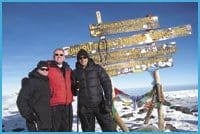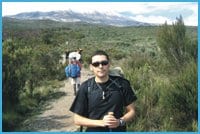
VIEW FROM THE TOP. Jefferson Guzman (right) with partner John and friend Elaine at Uhuru Peak, Mt Kilimanjaro. Credit: (John Campey)
Six months ago my partner John announced that he and our friends, Elaine and her partner Barbara, wanted to go to Africa and climb Kilimanjaro. It was then that the importance of couples taking separate vacations from time to time became very clear.
I’m not a sporty fag. Camping on the side of a mountain for a week is not my idea of a vacation. But the man I love was heading off on an adventure, one from which he might not return. I was scared of going but I was more afraid of letting the opportunity pass me by.
Kilimanjaro is the highest mountain in Africa and although you don’t need specialized training or equipment to hike to the top at 19,340 feet, less than 75 percent of those who attempt this feat make it all the way. In fact the mountain claims an average of 30 lives per year. So why exactly was I about to embark on such a challenging and dangerous trek? What else makes us act like fools? Love.
There was one element of this adventure that was right up my alley — shopping for a trekking wardrobe. As I crossed each item off my three-page list of clothing and gear it became apparent that the only training I was going to cram into my busy schedule was climbing up the stairs to the second floor at Mountain Equipment Co-op.
We flew over Uhuru Peak en route to the beginning of our mountaineering adventure. At a cruising altitude of 30,000 feet we were closer to the summit than we would be when we touched down. We landed in Tanzania and made our way to the Marangu Hotel, the home base for the company organizing our climb. I laid out my gear and matching mountain ensembles on the bed as instructed. Everything was inspected to ensure we had all we needed. We were briefed on the journey that would start the following morning.
It was a bumpy four-hour drive to Naremoru gate where we started the climb at an altitude of 5,900 feet. Our team of 14 porters made quick work of unloading the truck. Our head guide Valerian led the way into the forest.
Elaine, Barbara and John had no problem keeping up with Valerian’s brisk pace. I trailed behind and our two assistant guides, Michael and Gaspar, kept me company.
“Is John your father?” Michael asked. John is 20 years older than I am so I’ve tackled this embarrassing question before. But this time I hesitated to tell the truth.
In 2004 Zanzibar increased penalties for gay sex acts. Zanzibar, a group of islands off the coast, is part of Tanzania but partially self-governing. At first the government was considering instituting penalties of up to 25 years for sex acts between men and seven years for sex acts between women. Our decision not to visit Zanzibar’s beaches had been easy.
Since Zanzibar’s economy relies heavily on tourism activists called for a travel boycott in hopes that the government would reconsider adopting the penalties. The bill ultimately passed with adopted penalties set at five years for sex acts between individuals of the same sex — male or female — and seven years for same-sex couples living as spouses or celebrating a wedding ceremony. Still, many gay travel websites continue to advertise trips to Zanzibar.
In mainland Tanzania the debate on same-sex marriage is now underway. Currently the sentence is 14 years for sex acts between men. (The law makes no reference to women.) Same-sex couples risk attracting negative attention if they engage in public displays of affection.
“We’re friends” I answered. Like John and I, Elaine and Barbara also grappled with how to handle questions regarding their relationship. Lying didn’t sit well with any of us but in the end we all agreed that before coming out there had to be certainty that it was safe to do so.
***
An hour into our trek it began to rain. It was the dry season and we were on what is thought of as the dry side of the mountain, but on Kilimanjaro you must be prepared for all weather. After a four-hour, eight-kilometre hike we arrived at our first camp at 9,000 feet.
In addition to food, water and tents the porters carried our duffels; a maximum combined load of 25 kilos each. Despite being heavily weighed down they beat us to camp and had everything set up for our arrival, as they would continue to do each day. In need of dry clothes we were shown to our tents and given our duffels. Cisco the camp cook had supper waiting.
We had immense respect for how hard the porters worked and constantly expressed our gratitude. We were glad we selected a company that abided by the working conditions set by the Kilimanjaro Porters Assistant Project and paid above the minimum rates set by the Kilimanjaro National Park.
The rain let up in the night. After breakfast we followed the path through alpine moorland, past scrawny trees reminiscent of Dr Seuss illustrations. It was hot and my head pounded with each step. What happened to “pole, pole” — meaning slowly, slowly — which I’d heard so much about? In our briefing we were told it was crucial to hike slowly in order that our bodies acclimatize to the altitude. Drinking four litres of water each day would also help avoid the headaches and nausea known as mountain sickness. After a seven-hour hike we reached Kikelewa Cave at 12,100 feet. Having hiked 15 kilometres, I collapsed into my tent, sweaty, dirty and exhausted. We wouldn’t be able to shower for another four days. Sex was officially removed from the agenda.
***
At night the temperature dropped dramatically. I shivered in my sleeping bag. I felt certain I wasn’t going to make it all the way to the top and I’d made this clear before we started. John, Elaine and Barbara have each run numerous marathons. I have no athletic accomplishments. I’d been trailing behind all day.
By day four we crossed the high-altitude desert of the Saddle to Kibo Hut at 15,400 feet. The mountain loomed over us. At midnight we began the final six-hour climb to the summit. At night the terrain — which is mostly loose gravel, called scree — freezes, making it easier to climb. Plus, starting at midnight puts you at the top in time for sunrise.
I felt like my head was going to explode the nausea was so intense. Altitude kills; we were told to be vigilant of the warning signs. Cerebral edema, build-up of fluid around the brain: symptoms include severe headache, loss of balance, fits of anger. Pulmonary edema, build-up of fluid in the lungs: symptom is a liquid wheezing sound. Both kill within hours. The only cure is immediate descent. What would happen if I went any higher? Would I forgive myself if I didn’t try?
After three hours sleep my headache had subsided. I dressed for severe cold, estimated at 20 below zero. Note to self: Never again go camping in winter conditions.
I turned on my headlamp. I had saved my iPod for this part of the climb, having been warned it would be the hardest. I listened to Radiohead’s then-new album In Rainbows. The music energized me.
We followed the mass exodus out of camp and merged into a single-file line. The climb was physically and mentally taxing. The thin air made it difficult to breathe and move. Every three to 10 steps I rested briefly.
There could have been 100 people in the line, yet there was a feeling of solitude. Looking up it was hard to differentiate between climbers’ headlamps and stars. The processional was spiritual, peaceful, beautiful. I gave myself over to the rhythm of the shuffle.
***
Three hours later we arrived at Hans Meyer Cave at 17,000 feet. Barbara didn’t look well. Hypoglycemia and hypothermia made it impossible for her to continue. She urged us on and hugged us goodbye. Gaspar accompanied her down.
We pushed ahead as others turned back; some were carried. With no end in sight it was time to admit that I too needed to turn back. I paused in front of a woman who stood looking at the face of each climber as they passed. She smiled reassuringly and said, “You’re three minutes away from the top.” I kept going.
It was still dark when John took my picture next to the welcome sign at Gilman’s Point. We had made it to the crater’s snow-capped rim. If we turned back now we would get a certificate. If we continued another 90 minutes we would reach the highest point, Uhuru Peak, and our certificate would have a gold band.
The sun was rising. My headache was back with a vengeance. Michael saw me struggling and took my backpack. “You will make it,” he said, “even if you go slowly slowly.”
Those 90 minutes were the most challenging of my life. It wasn’t until I could see the sign for Uhuru Peak in the distance that I knew I would make it. When I arrived I started to cry. John held me and whispered, “I knew you could make it.”
At 19,340 feet we were above the clouds. The sunrise revealed immense glaciers. Valerian announced we only had 15 minutes to enjoy the view, as it was dangerous to remain at this altitude for long.
Our decent was a relief but also daunting. Valerian moved quickly to gain momentum then dug his heels into the melted scree and slid down 15 metres. It was faster going down but not easier. Elaine and John quickly mastered the technique but I could not find the balance needed to surf the scree.
Michael and Valerian each grabbed hold of one of my arms. For three hours they pulled me along as we surfed the scree at an overwhelming speed. By noon we reunited with Barbara and by evening had arrived at Horombo Hut. We had hiked a total of 14 hours; six kilometres up, 21 kilometres down.
The next morning I could barely move. A final six-hour, 27-kilometre hike stood between me and a shower and real bed. As we concluded our adventure Elaine and John agreed it was the hardest physical challenge they had ever undertaken, harder than any marathon.
After returning home to Toronto I edited together video clips I took on the climb, setting them to the music I’d listened to during that final push to the top. I was reminded of the beauty that surrounded us on Kilimanjaro, the amazement of walking through diverse climate and vegetation zones, the exhilaration of standing above the clouds.
I was thankful I had stopped to marvel at all this, to take pictures and video, even though it often meant trailing behind the group. As I watched the final cut I found myself thinking, “I will climb that mountain again… but first, I have a marathon to run.”
Maybe I’m a sporty fag after all.

 Why you can trust Xtra
Why you can trust Xtra